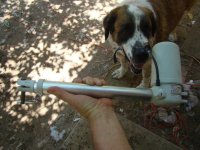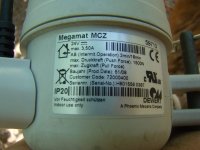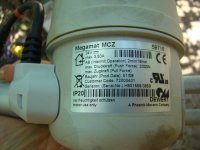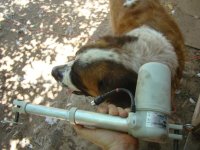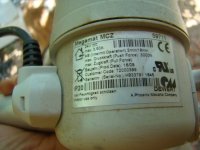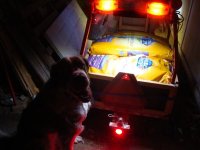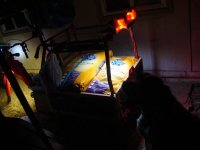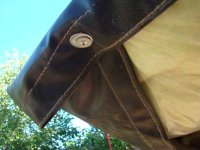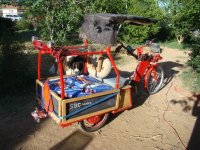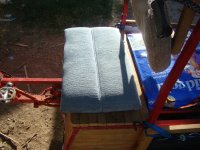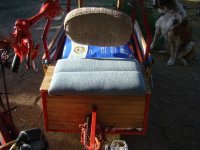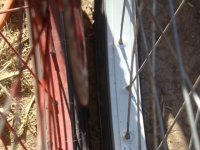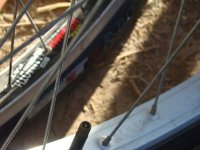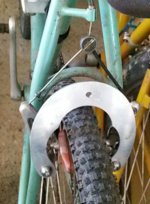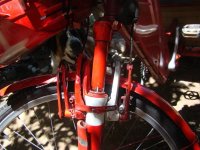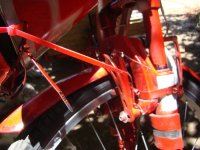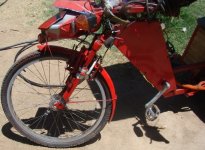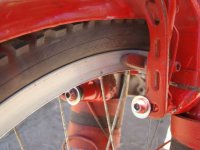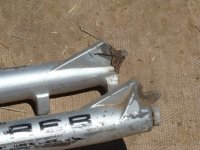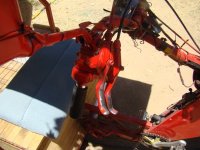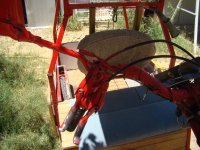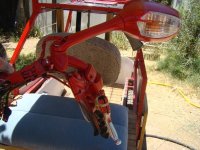Last week, on bulk trash dump/pickup, someone left a LaZBoy recliner that had a cat peed seat out in the alley behind my house. But while most of it was unsalvageable, not all of it had pee on it; for instance the foldout footrest did not, and it is very well padded. It's also almost as wide as my seatbox, only shy about a couple inches or less on each side.
It should work quite a bit better than the old office/computer chair seat I've been using, which isnt' flat on the bottom and rocks back and forth as I ride. This might turn out to have been helpful in shock absorption, so I may end up putting it back, but I'll try the "bench seat" with the ex-footrest first.
The only issue with mounting it is that if placed square on the cover, it will cover up the lock. So I'll have to mount it forward an inch or so from the rear of the cover to clear the lock.
I've also gotten started removing the old BigDog blue canopy cover, and replacing it with the brown water resistant vinyl cover, though I'm still working out how it will attach. Probably rivets along the bottom of the canopy frame.
also, the lazyboy chair had some linear actuators in it, 24vdc, which I saved, but I dunno what I'll do with them. At one time I wanted to use something like that to lower/raise low-speed "training wheels" on Crazybike2, like AussieJester did on his bike, so that when I slowed enough to be unstable they'd lower down automaticaly, or I could do it with a button press, and they'd raise when above that unstable speed, so I wouldn't have to put my feet down to teh ground, could keep both on the pedals. Then it would actually be possible to pedal the bike if motor system failed, because I'd be able to gear it down real low like the SB Cruiser is now.
I thought of several whimsical things to do with them on SB Cruiser, inclduing a retractable canopy or a dumptruck cargo bed, etc. But nothing practical.
It should work quite a bit better than the old office/computer chair seat I've been using, which isnt' flat on the bottom and rocks back and forth as I ride. This might turn out to have been helpful in shock absorption, so I may end up putting it back, but I'll try the "bench seat" with the ex-footrest first.
The only issue with mounting it is that if placed square on the cover, it will cover up the lock. So I'll have to mount it forward an inch or so from the rear of the cover to clear the lock.
I've also gotten started removing the old BigDog blue canopy cover, and replacing it with the brown water resistant vinyl cover, though I'm still working out how it will attach. Probably rivets along the bottom of the canopy frame.
also, the lazyboy chair had some linear actuators in it, 24vdc, which I saved, but I dunno what I'll do with them. At one time I wanted to use something like that to lower/raise low-speed "training wheels" on Crazybike2, like AussieJester did on his bike, so that when I slowed enough to be unstable they'd lower down automaticaly, or I could do it with a button press, and they'd raise when above that unstable speed, so I wouldn't have to put my feet down to teh ground, could keep both on the pedals. Then it would actually be possible to pedal the bike if motor system failed, because I'd be able to gear it down real low like the SB Cruiser is now.
I thought of several whimsical things to do with them on SB Cruiser, inclduing a retractable canopy or a dumptruck cargo bed, etc. But nothing practical.


